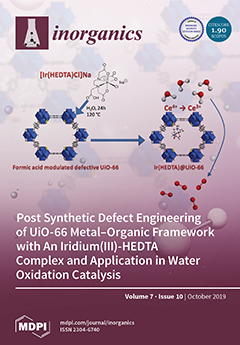Divalent metal oxidoarsenates(V) with compositions
M(H
2AsO
4)
2(H
3AsO
4)
2 (
M = Mg, Mn, Co, Ni),
M(HAsO
4)(H
3AsO
4)(H
2O)
0.5 (
M = Mn, Cd) and Zn(HAsO
4)(H
3AsO
4) were obtained from solutions containing an excess of arsenic acid. Single crystal X-ray diffraction revealed isotypism of the
M(H
2AsO
4)
2(H
3AsO
4)
2 (
M = Mg, Mn, Co, Ni) structures with the known Cu and Zn members of this series whereas
M(HAsO
4)(H
3AsO
4)(H
2O)
0.5 (
M = Mn, Cd) and Zn(HAsO
4)(H
3AsO
4) crystallize in novel structure types. The two isotypic
M(HAsO
4)(H
3AsO
4)(H
2O)
0.5 (
M = Mn, Cd) structures are closely related with that of Zn(HAsO
4)(H
3AsO
4). Both comprise undulating centrosymmetric
MO
4/2O
2/1] chains that share corners with HAsO
42− tetrahedra and H
3AsO
4 tetrahedra to build up layers extending along (001). Intermediate water molecules (occupancy 0.5) link adjacent layers in the water-containing compound whereas the linkage in the Zn-compound is mediated by weak hydrogen bonding interactions between the layers. Results of a quantitative comparison between all known structures of the
M(H
2XO
4)
2(H
3XO
4)
2 (
M = Mg, Mn, Co, Ni, Cu, Zn;
X = P, As) series as well as between the two
M(HAsO
4)(H
3AsO
4)(H
2O)
0.5 (
M = Mn, Cd) structures are presented.
Full article





